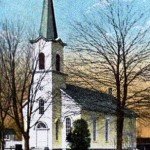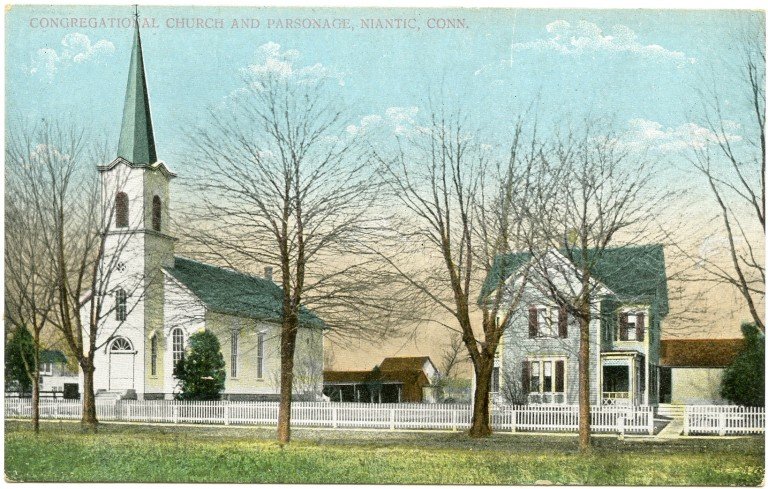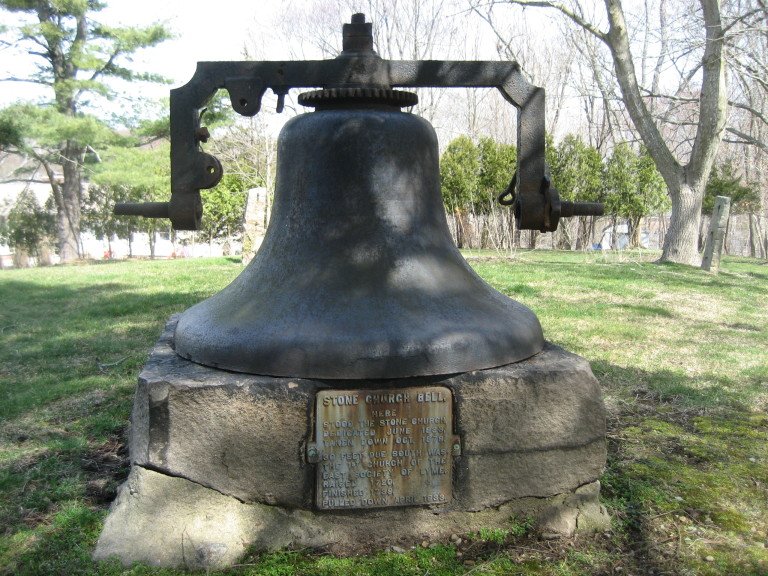NCC History
Roots reaching back to colonial days …
Formed by the merger of the local Congregational and Methodist Churches, the Niantic Community Church has a local history on its Congregational side going back to 1718 and 1810 on its Methodist side.
In May 1718, the legislature authorized the inhabitants of the “Second Society of Lyme to embody themselves in church order and settle an orthodox minister.” Church records reveal that “on the 15th of February, 1719 the first society meeting was called and it was voted that Mr. George Griswold should be the minister for the society to preach ye gospel.”
The first pastor of the Second or East Society of Lyme would be a remarkable man in any time or place. He belonged to the wealthiest and most aristocratic family in this section of the Colony. His family owned thousands of acres of land on the east side of the Connecticut River. Rev. Griswold was graduated from Yale in 1717, before the college moved from Saybrook to New Haven. In 1719 at the age of 27 he began preaching here. In 1722 a small wooden meeting house was built as near as possible to the center of town. When the first school districts were formed, they all cornered at the old meeting house. Besides his duties in his own church, he held a commission from the “Society for the Propagation of the Gospel in New England” as missionary to the Nehantic Indians.
A religious revival…
For the next twenty years the church was at peace. The ancient records are interesting for the quaint customs and quainter spelling of the day. About 1740 a religious revival began and soon swept over all of New England. The little church in East Lyme felt its influence and in that year 116 persons were added to its number. Of those, 15 were Indians.
The Rev. George Griswold, minister, 1719-1761 (ordained in 1724). Buried in the Old Stone Church Burial Ground.
The 41 year long pastorate of Mr. Griswold ended with his death in 1761. He was buried across the street from his loving church in the burial ground. However, the church had begun its decline before the death of its beloved pastor. Without his influence troubles arose quickly and by 1793 there remained “only two aged females”. Preaching was done by visitors, in private homes, and sometimes as few as two services were held a year. The little wooden structure was in a sad state of disrepair. It is said the doors had fallen off and sheep and cattle wandered inside. In the spring of 1793 the “two aged females” recruited a few individuals and together repaired the meeting house and managed to obtain the services of Rev. Lynde Huntington to preach during the summer. On the seventh of December 1793 the small group gathered and reorganized to form the church of Christ on the Congregational plan. At this time there were 22 members. For the next 28 years there was a minister only during the summer months. However, the faithful little congregation met each Sabbath for religious worship. These meetings, so constantly maintained, were the means of keeping the church alive, and prepared the way of the resettlement of a minister among them.
In 1810, a Methodist class of four or five …
In 1810 a Methodist class of four or five was organized. The number of attendants did not increase however, and the enterprise was abandoned.
Postcard depicting the Stone Church, built 1833; razed 1879.
During the congregational pastorate of Rev. Herman L. Vaill, 1828 to 1836, “the Old Stone Church” was built. It was built of undressed stone from the nearby quarries, 50 feet by 35 feet. There were four stately pillars in front and marble floors. It was topped with a graceful belfry and spire. The whole expense was estimated at $2,500. The new meeting house was apparently used for the first time in January of 1833. In the baptismal register and membership lists appear names of many of the old families of East Lyme. Rev. Frederick Gridley served as pastor from 1836 to 1856 and also maintained a private school, to which came youths from many places to prepare for college. The Methodist Class started so many years earlier was revived in 1836 and meetings were maintained regularly from that date. The first Methodist Church of East Lyme was built in 1843 on land given by Captain Avery Smith. The cost of this building was about $1,000. In 1858 the first parsonage was built on land rear to the church. Captain Smith also gave this lot.
As the years went by local conditions changed …
The building of a railroad in the southern part of town shifted the population away from the north. The Old Stone Church once so central was now remote and its congregation dwindled. The time came when everyone admitted that the old church must be given up and a place of worship secured in the growing village of Niantic.
In 1870 when it became necessary to raise funds for the operation of the church, the marble “stuff” including the porch floor of the Old Stone Church was sold.
In 1876 a committee was chosen to find a suitable location in the village of Niantic for the new church building. In March of that year a lot on Lincoln Street was given by Mrs. Lydia M. Lee. Shortly after this building began. The Church was built after the fashion of that day. It had a fine colonial spire that stood out above the treetops. The church was first used for meetings in March 1879. A few years later a parsonage was built next door. The hurricane of 1938 tore down the steeple and the expense of replacement was too great.
1930s postcard image of the Congregational Church on Lincoln Street, built 1878.
In April of 1878 the parsonage and other buildings of the “Old Stone Church” were sold at a public auction. After a time this property was sold again, and the church torn down. Part of the stone was used to build an icehouse, and some was used to build the fireplace in the old Niantic Library. All that remains on the original site is the old bell and a few of the stones. [Click here to read about the Old Stone Burial Ground]
1930s postcard image of the Methodist Church: built 1873; razed 1954.
By 1873 the Methodists congregation had outgrown its meeting house, and a new church was built nearer to the village, on Main Street. A few years later a new parsonage was also built on Main St. During 1893 labor problems arose in the quarries here and in Waterford, and indeed the entire country fell into a depression. The congregation of both churches diminished.
Starting with the depression of the 1930’s and the war in Europe the active life of both churches became impaired. In the middle 1940’s they were faced with the possibility of closing. Realizing the consequences of closing, they began to explore the pros and cons of joining. Each church chose a committee to check into the matter. After three years of careful study; seemingly hundreds of meetings; a time of joint worship services; and complete investigation; a meeting was held in April 1953 and the proposition of the merger was put to a vote. The Niantic Community Church was incorporated on June 1, 1953.
Groundbreaking at 170 Pennsylvania Avenue on 12 June 1960. L to R: Robert McNeil, chair, Board of Trustees; the Rev. Allen Tinkham, pastor; the Rev. Harvey Mousley, Superintendent of the NOrwich District for the Methodist Church’s Southern New England Conference, and the Rev. Dr. James English, superintendent of the State Conference, Congregational Christian Churches.
Noting that its present facilities were inadequate for its growing ministry, the church made preparation for a new building to be built. These plans culminated in the present church. A groundbreaking service was held on June 12, 1960 and the first service in the new building was conducted on June 11, 1961. The Congregational Church on Lincoln St. and the parsonage next door are now both private residences. The first Methodist parsonage on Pattagansett Court and the second on Main St. are also private homes.
The Old Stone Church Burial Ground
East gates to the Old Stone Church Burial Ground on Riverview Road
In 1831 the new stone church was built just north of the wooden building and another acre was added to the burial ground on the west side. It was also enclosed by a wall with a double gate on the north side and a single gate in the east wall. That single gate was replaced in the 1950’s with a double gate. The Stone Church was taken down in 1879, but its bell is still located across the street on the hill.
Many different types of stone markers are in our burial ground. The first were carved from fieldstone, and then slate was used. Sandstone became very popular because it was easy to carve, but many of those stones do not survive. Marble and granite then became the stone of choice for its durability. Unfortunately many of those were affected by acid rain and the faces of some of the stones are wearing away. We have one monument that is made of zinc or white metal. This type became very popular in the mid/late 1800’s. You could order the style you liked from a catalog and then a small plaque was made and bolted to it.
Page 245, Volume III, Lyme Records: Janawar ye 28, 1719-20 Then laid out for Nehantic Querter one acre of land for a burying place…also one hundred acres for the support of ye ministry…preserving a highway 25 rods wide between.
Samuel Marvin, Thomas Lee, lott layers
In 1719, when those living in this section of Lyme received permission to establish the Second or East Ecclesiastical Society of Lyme, they prepared to built their first wooden structure on top on a hill in what was the center of this community. At the same time they laid out one acre of land as a burial ground. That area consisted of the east side of the present burial ground, went as far as the present location of the north gates, and followed the path to the present location of the east gates.
Many of the early burials were in graves only marked with field stones and were located in the flat, center part of the site. Grave stones were expensive and there were few carvers at that time, but by the late 1700’s there were 50 carvers in Connecticut. The oldest marked stone at this site is from 1722 and the oldest with a name is that of George Smith from 1724.
Stone Church bell, located at the Stone Church site on Society Road.
When you look at the burial ground, you can see the older sections from the newer by the types of stone. There are also many types of carvings on the stones from death’s heads to winged cherubs to urns and willow trees. We have over 500 marked graves in the burial ground and as many as 500 unmarked graves. Three of the early ministers are buried here. Rev. George Griswold who was the minister from 1724-1761, Rev. John St. John, minister from 1823-1827 and Frederick Gridley, 1836-1856. There are 100 veterans here from the colonial wars to WWII. The town’s Civil War monument is located on the hill and was placed there in 1926. Many of the town’s early founders are also buried here. At present there are no full burial plots available, but an area has been prepared for cremation plots.
A 300-year timeline of NCC
As part of the Church’s 300th anniversary the worship team developed a visual presentation of the church’s spiritual progression over the three centuries, in a chronological fashion, that would be a valuable artifact to convey to a larger audience within and beyond the current membership. The timeline, laid out on five charts, depicts significant events and pivotal decisions during the past 300 years and how the past informs who we are today. During the celebratory period, the timeline is displayed in the multi-purpose room for your viewing. Click on the links below to view the timeline and chronological list.










